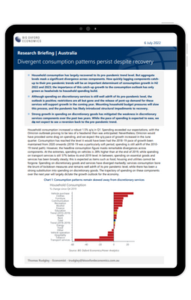Divergent consumption patterns persist despite recovery

Household consumption increased a robust 1.5% q/q in Q1. Spending exceeded our expectations, with the Omicron outbreak proving to be less of a headwind than was anticipated. Nevertheless, Omicron would have provided some drag on spending, and we expect the q/q pace of growth increased in the June quarter. Consumption has reached the level it would have been had the 2018-19 pace of growth been maintained from 2020 onwards (2018-19 was a particularly soft period; spending is still adrift of the 2010- 19 trend path). However, the headline consumption figure masks remarkable divergences across components.
What you will learn:
-
Household consumption has largely recovered to its pre-pandemic trend level. But aggregate levels mask a significant divergence across components. How quickly lagging components catchup to their pre pandemic trends will be an important determinant of consumption growth in H2 2022 and 2023; the importance of this catch-up growth to the consumption outlook has only grown as headwinds to household spending build.
-
Although spending on discretionary services is still well adrift of its pre-pandemic level, the outlook is positive; restrictions are all but gone and the release of pent-up demand for these services will support growth in the coming year. Mounting household budget pressures will slow this process, and the pandemic has likely introduced structural impediments to recovery.
-
Strong growth in spending on discretionary goods has mitigated the weakness in discretionary services components over the past two years. While the pace of spending is expected to ease, we do not expect to see a reversion back to the pre-pandemic trend.
Tags:
Related posts

Post
Navigating Australia’s Labour Market
Explore July's labour market update: unemployment dips to 4.2%, showing stability despite economic challenges. Learn how these trends may impact the future.
Find Out More
Post
Understanding Australia’s Goods Trade Dynamics in 2025
2. Explore Australia's goods trade dynamics, with rising exports and falling imports. Learn how global demand impacts the trade balance and future projections.
Find Out More
Post
Households open their wallets as an August rate cut looms in Australia
Household spending rose in June, driven by EOFY sales, but subdued per capita growth and labour market softness reinforce expectations of an RBA rate cut.
Find Out More